
|
Now it is 7.5 mag (May 27, Chris Wyatt). It was expected to brighten up to 6-7 mag from April to July. But it is fainter than predicted recently. In the Northern Hemisphere, it stays observable in excellent condition until June. In the Southern Hemisphere, it becomes observable in good condition after this.
Date(TT) R.A. (2000) Decl. Delta r Elong. m1 Best Time(A, h)
June 3 14 40.67 20 31.8 0.812 1.642 127 6.7 21:51 (180, 35)
June 10 14 29.67 12 51.3 0.816 1.637 126 6.7 21:13 (180, 43)
|
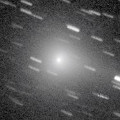
|
Outburst occured on Apr. 4, and it brightened by 2 mag, up to 6.2 mag (Apr. 7, Juan Jose Gonzalez). It is very bright as 7.9 mag still now (May 24, Juan Jose Gonzalez). It stays observable for a long time after this. But it locates low in the Northern Hemisphere.
Date(TT) R.A. (2000) Decl. Delta r Elong. m1 Best Time(A, h)
June 3 1 5.78 12 27.6 1.389 1.117 52 7.7 5:30 (228, 28)
June 10 1 28.53 14 35.5 1.436 1.163 53 7.9 5:33 (225, 27)
|
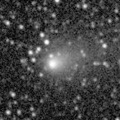
|
Now it is bright as 10.9 mag (May 30, Marco Goiato). It is observable in excellent condition in the Southern Hemisphere. It locates low in the Northern Hemisphere.
Date(TT) R.A. (2000) Decl. Delta r Elong. m1 Best Time(A, h)
June 3 16 34.91 -27 38.1 0.595 1.608 174 10.6 23:46 (180, 83)
June 10 16 31.66 -29 21.2 0.590 1.598 168 10.4 23:15 (180, 85)
|
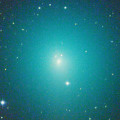
|
It approached to Earth down to 0.14 a.u. from late March to early April, and it brightened up to 6.0 mag (Apr. 7, Juan Jose Gonzalez). Now it is fading. But it is bright as 9.5 mag still now (May 29, Chris Wyatt). It is observable in excellent condition in the Northern Hemisphere. It is observable in good condition after this also in the Southern Hemisphere.
Date(TT) R.A. (2000) Decl. Delta r Elong. m1 Best Time(A, h)
June 3 18 28.59 13 26.1 0.301 1.249 135 10.6 1:44 (180, 41)
June 10 18 24.67 8 48.7 0.334 1.299 143 11.4 1:12 (180, 46)
|

|
It has not been observed yet in this apparition. The condition of this apparition is worst. It will brighten up to 10 mag in spring, but not observable at all.
Date(TT) R.A. (2000) Decl. Delta r Elong. m1 Best Time(A, h)
June 3 5 18.16 17 35.2 2.209 1.220 9 11.4 18:25 (105, -9)
June 10 5 45.16 17 18.3 2.257 1.267 9 11.6 18:25 (105, -8)
|
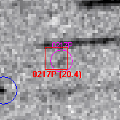
|
Now it is 14.0 mag (May 19, Kunihiro Shima). It will brighten rapidly, and it is expected to brighten up to 12 mag from July to September. In the Southern Hemisphere, it stays at the same altitude in the morning sky. In the Northern Hemisphere, it will be getting higher slowly.
Date(TT) R.A. (2000) Decl. Delta r Elong. m1 Best Time(A, h)
June 3 0 58.68 0 30.0 1.563 1.353 58 13.5 5:30 (236, 38)
June 10 1 25.23 2 12.9 1.521 1.320 58 13.2 5:33 (233, 37)
|

|
Outburst occured on Apr. 23. It is bright as 13.3 mag still now (May 29, Chris Wyatt).
Date(TT) R.A. (2000) Decl. Delta r Elong. m1 Best Time(A, h)
June 3 21 42.16 -13 30.8 5.430 5.841 109 13.4 4:57 (180, 68)
June 10 21 42.24 -13 24.5 5.326 5.839 115 13.4 4:29 (180, 68)
|
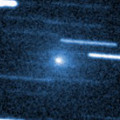
|
Now it is 10.9 mag (Apr. 30, Marco Goiato). It will be fading gradually after this. It is not observable now in the Northern Hemisphere. In the Southern Hemisphere, it stays observable for a long time, but it stays low.
Date(TT) R.A. (2000) Decl. Delta r Elong. m1 Best Time(A, h)
June 3 2 9.17 6 16.8 1.895 1.303 40 13.6 5:30 (245, 21)
June 10 2 27.59 6 55.2 1.949 1.387 42 14.1 5:33 (243, 23)
|
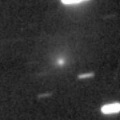
|
Now it is 14.7 mag (Feb. 20, Thomas Lehmann). It is not observable now in the Northern Hemisphere. It will be unobservable temporarily in May also in the Southern Hemisphere. It will be getting higher gradually in the morning sky after summer. Then it will be observable at 11 mag for a long time from 2017 autumn to 2018 winter.
Date(TT) R.A. (2000) Decl. Delta r Elong. m1 Best Time(A, h)
June 3 4 7.01 -9 59.6 5.114 4.304 33 13.9 5:30 (277, 7)
June 10 4 13.64 -9 11.8 5.041 4.253 35 13.8 5:33 (273, 12)
|
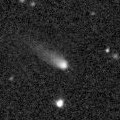
|
Now it is 15.6 mag (Feb. 15, Alexander Baransky). Appearing in the morning sky. It will brighten up to 12-13 mag and will be observable in good condition in summer.
Date(TT) R.A. (2000) Decl. Delta r Elong. m1 Best Time(A, h)
June 3 0 18.42 15 44.4 3.188 2.865 62 14.0 5:30 (215, 31)
June 10 0 15.13 15 53.0 3.030 2.844 69 13.9 5:33 (206, 35)
|
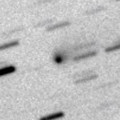
|
Now it is 13.7 mag (May 26, Chris Wyatt). It will brighten up to 14 mag from spring to summer. It locates somewhat low in the Northern Hemisphere. The perihelion distance increased from 2.4 a.u. to 2.9 a.u. in this apparition. So it will not be bright as before.
Date(TT) R.A. (2000) Decl. Delta r Elong. m1 Best Time(A, h)
June 3 16 1.26 -21 36.1 1.984 2.988 170 14.0 23:12 (180, 77)
June 10 15 56.08 -21 42.2 1.997 2.980 162 14.0 22:40 (180, 77)
|
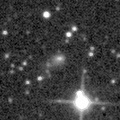
|
Now it is 15.1 mag (May 20, Kunihiro Shima). It will be observable at 14 mag for a long time from 2017 to 2018.
Date(TT) R.A. (2000) Decl. Delta r Elong. m1 Best Time(A, h)
June 3 18 17.42 18 54.0 3.623 4.377 132 14.6 1:33 (180, 36)
June 10 18 6.27 20 10.3 3.570 4.346 134 14.5 0:54 (180, 35)
|
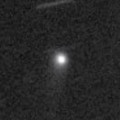
|
Now it is 16.4 mag (May 18, Kunihiro Shima). In the Northern Hemisphere, it will brighten up to 14 mag from summer to winter, and it will be observable in excellent condition. In the Southern Hemisphere, it will be observable in the very low sky only from May to June.
Date(TT) R.A. (2000) Decl. Delta r Elong. m1 Best Time(A, h)
June 3 0 30.38 31 25.8 3.807 3.355 56 14.7 5:30 (210, 16)
June 10 0 34.09 33 53.0 3.707 3.336 61 14.6 5:33 (203, 17)
|
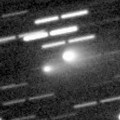
|
It brightened up to 11.5 mag from late March to early April (Mar. 24, Andrew Pearce). Now it is fading. It has already faded down to 15.6 mag (May 6, CAO, San Pedro de Atacama). Bright 12-mag new fragment BT was discovered on Feb. 10, but now it is faint as 16.7 mag (Apr. 18, F.-J. Hambsch, E. Bryssinck). In the Southern Hemisphere, it stays observable for a long time after this. It is getting observable in the morning sky again also in the Northern Hemisphere.
Date(TT) R.A. (2000) Decl. Delta r Elong. m1 Best Time(A, h)
June 3 1 32.25 0 15.4 1.832 1.439 51 15.1 5:30 (243, 32)
June 10 1 47.03 1 30.4 1.850 1.502 54 15.4 5:33 (239, 34)
|
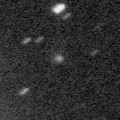
|
Now it is 15.6 mag (May 20, Kunihiro Shima). It is expected to brighten up to 9 mag in summer in 2018. In the Northern Hemisphere, it stays observable until 2018 summer while the comet will be brightening. In the Southern Hemisphere, it is hardly observable in 2017, but it will be observable in good condition in 2018.
Date(TT) R.A. (2000) Decl. Delta r Elong. m1 Best Time(A, h)
June 3 18 38.27 54 5.8 4.742 5.014 99 15.4 1:53 (180, 1)
June 10 18 29.23 54 8.4 4.660 4.957 101 15.3 1:17 (180, 1)
|

|
Now it is 15.6 mag (Mar. 6, Kunihiro Shima). It is appearing in the morning sky in the Southern Hemisphere. It will appear in the morning sky in July in the Northern Hemisphere. Then it stays observable at 15.5 mag unil the end of 2017.
Date(TT) R.A. (2000) Decl. Delta r Elong. m1 Best Time(A, h)
June 3 2 46.57 4 21.3 6.383 5.566 33 15.5 5:30 (253, 15)
June 10 2 52.36 4 32.5 6.348 5.589 38 15.5 5:33 (249, 20)
|
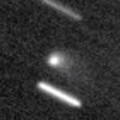
|
Now it is 16.8 mag (Apr. 7, MASTER-OAFA Observatory). It will brighten up to 15.5 mag in summer. It will be observable in excellent condition in the Southern Hemisphere. In the Northern Hemisphere, it stays unobservable for some more time.
Date(TT) R.A. (2000) Decl. Delta r Elong. m1 Best Time(A, h)
June 3 22 1.05 -39 28.8 1.965 2.525 111 16.0 5:16 ( 0, 86)
June 10 22 5.12 -38 42.0 1.885 2.513 116 15.9 4:52 ( 0, 86)
|
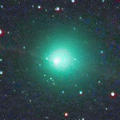
|
Now it is fading rapidly. It has already faded down to 12.3 mag (Apr. 28, Chris Wyatt). In the Southern Hemisphere, it stays observable in good condition after this while the comet will be fading. It locates low in the Northern Hemisphere.
Date(TT) R.A. (2000) Decl. Delta r Elong. m1 Best Time(A, h)
June 3 22 51.04 -17 49.6 1.175 1.618 95 15.9 5:30 (207, 71)
June 10 22 46.25 -18 28.2 1.162 1.705 102 16.3 5:33 (180, 73)
|
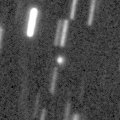
|
Now it is 16.3 mag (Apr. 30, T. Ikemura, H. Sato). It is expected to brighten up to 11-12 mag from 2018 to 2019. In the Northern Hemisphere, it stays observable in good condition while the comet will be brightening gradually. In the Southern Hemisphere, it is not observable until 2018 October.
Date(TT) R.A. (2000) Decl. Delta r Elong. m1 Best Time(A, h)
June 3 17 22.89 60 12.0 4.600 4.832 97 16.1 0:38 (180, -5)
June 10 17 7.15 61 0.0 4.566 4.780 96 16.0 23:49 (180, -6)
|

|
Now it is 16.6 mag (May 20, Kunihiro Shima). It stays 16-17 mag for a long time from 2016 to 2019. It stays near by the equator.
Date(TT) R.A. (2000) Decl. Delta r Elong. m1 Best Time(A, h)
June 3 9 15.14 7 0.7 9.925 9.573 66 16.1 18:25 (141, 40)
June 10 9 17.65 7 3.2 10.024 9.571 60 16.1 18:25 (134, 36)
|

|
It has not been recovered yet in this apparition. It will brighten rapidly, and it is expected to be observable at 15.5 mag in good condition from July to September.
Date(TT) R.A. (2000) Decl. Delta r Elong. m1 Best Time(A, h)
June 3 0 15.09 -17 22.3 2.576 2.543 76 16.2 5:30 (244, 58)
June 10 0 24.66 -16 24.6 2.499 2.539 80 16.2 5:33 (236, 61)
|

|
It brightened up to 11 mag from spring to summer in 2016. Now it is 17.4 mag (May 19, Kunihiro Shima). It is observable at 16-17 mag in good condition from spring to summer.
Date(TT) R.A. (2000) Decl. Delta r Elong. m1 Best Time(A, h)
June 3 20 32.10 -17 0.2 2.391 3.100 126 16.2 3:47 (180, 72)
June 10 20 29.53 -17 10.9 2.351 3.138 133 16.3 3:17 (180, 72)
|

|
Now it is 15.8 mag (May 28, iTelescope Observatory, Siding Spring). It stays 16 mag for a long time until summer in 2018. In the Southern Hemisphere, it stays observable in excellent condition until autumn. It locates low in the Northern Hemisphere.
Date(TT) R.A. (2000) Decl. Delta r Elong. m1 Best Time(A, h)
June 3 17 7.62 -38 51.9 2.478 3.459 162 16.4 0:23 ( 0, 86)
June 10 17 2.92 -38 28.9 2.424 3.412 164 16.3 23:47 ( 0, 87)
|
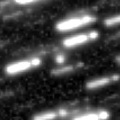
|
It was observed at 17 mag in 2016. In 2017, it will be observable at 15.5 mag in good condition from summer to autumn.
Date(TT) R.A. (2000) Decl. Delta r Elong. m1 Best Time(A, h)
June 3 0 43.11 3 45.1 3.167 2.819 61 16.3 5:30 (229, 38)
June 10 0 51.43 4 58.7 3.087 2.818 65 16.3 5:33 (223, 40)
|

|
Now it is 15.7 mag (Apr. 23, D. Buczynski). It stays 16 mag from 2016 to 2017. In the Northern Hemisphere, it stays observable in good condition for a long time. In the Southern Hemisphere, it will never be observable again.
Date(TT) R.A. (2000) Decl. Delta r Elong. m1 Best Time(A, h)
June 3 18 51.87 62 42.1 6.254 6.358 91 16.3 2:06 (180, -8)
June 10 18 46.74 63 37.0 6.260 6.367 91 16.3 1:34 (180, -9)
|
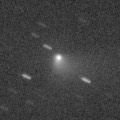
|
Small outburst occured in mid March, and it brightened up to 12.3 mag (Mar. 15, Juan Jose Gonzalez). Now it is fading. It has already faded down to 16.0 mag (Apr. 30, Catalina Sky Survey). It is still bright visually as 13.9 mag (May 27, Jakub Cerny). It is observable in excellent condition in the Northern Hemisphere. It stays low in the Southern Hemisphere.
Date(TT) R.A. (2000) Decl. Delta r Elong. m1 Best Time(A, h)
June 3 11 44.43 20 40.6 2.503 2.787 95 16.3 18:57 (180, 35)
June 10 11 49.72 19 9.2 2.611 2.813 90 16.5 18:35 (180, 36)
|
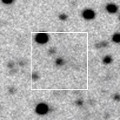
|
Now it is 17.4 mag (Apr. 30, Thomas Lehmann). It was expected to brighten up to 12 mag in summer. But actually, it is fainter than expected by 3-4 mag. It is observable in excellent condition in the Southern Hemisphere. It locates somewhat low in the Northern Hemisphere.
Date(TT) R.A. (2000) Decl. Delta r Elong. m1 Best Time(A, h)
June 3 19 29.68 -33 6.9 1.274 2.165 141 16.6 2:45 (180, 88)
June 10 19 28.54 -32 58.5 1.212 2.144 148 16.4 2:16 (180, 88)
|
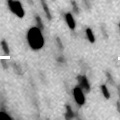
|
Now it is 16.1 mag (May 2, D. Buczynski). It was observed at 16 mag from spring to summer in 2016. It will be observable at 16 mag also in 2017 from winter to spring.
Date(TT) R.A. (2000) Decl. Delta r Elong. m1 Best Time(A, h)
June 3 18 16.83 23 4.5 2.904 3.632 129 16.5 1:32 (180, 32)
June 10 18 12.66 24 23.2 2.922 3.663 130 16.6 1:00 (180, 31)
|

|
It stayed bright 12 mag for a long time from autum in 2015 to summer in 2016. Now it is fading. It has already faded dwon to 16.6 mag (May 18, Kunihiro Shima).
Date(TT) R.A. (2000) Decl. Delta r Elong. m1 Best Time(A, h)
June 3 16 31.16 -12 40.5 4.121 5.122 169 17.0 23:42 (180, 68)
June 10 16 24.60 -13 13.4 4.187 5.174 165 17.1 23:08 (180, 68)
|

|
Now it is 17.0 mag (May 29, iTelescope Observatory, Siding Spring). It will brighten up to 14.5 mag in winter. In the Southern Hemisphere, it stays observable in excellent condition until spring in 2018. In the Northern Hemisphere, it stays unobservable until 2018.
Date(TT) R.A. (2000) Decl. Delta r Elong. m1 Best Time(A, h)
June 3 23 7.39 -58 6.7 2.776 3.203 105 17.3 5:30 (343, 65)
June 10 23 22.89 -59 52.0 2.675 3.148 108 17.1 5:33 (349, 65)
|
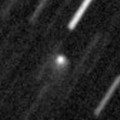
|
Now it is 16.6 mag (Apr. 29, T. Ikemura, H. Sato). It is observable at 17 mag in good condition in spring. It locates somewhat low in the Northern Hemisphere.
Date(TT) R.A. (2000) Decl. Delta r Elong. m1 Best Time(A, h)
June 3 11 53.84 -13 31.4 4.524 4.979 111 17.2 19:06 (180, 69)
June 10 11 51.99 -12 7.5 4.644 4.983 103 17.3 18:37 (180, 67)
|

|
It brightened up to 6.2 mag in June in 2016 (June 24, Marco Goiato). Now it is 17.3 mag (May 19, Kunihiro Shima). In the Southern Hemisphee, it stays observable in excellent condition after this. It stays low in the Northern Hemisphere.
Date(TT) R.A. (2000) Decl. Delta r Elong. m1 Best Time(A, h)
June 3 12 33.27 -23 58.5 4.445 5.068 122 17.3 19:45 (180, 79)
June 10 12 29.72 -23 3.8 4.611 5.133 115 17.4 19:14 (180, 78)
|
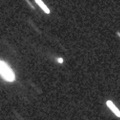
|
Now it is 16.3 mag (Apr. 30, T. Ikemura, H. Sato). It brightened rapidly, and became brighter than originally expected. It stays 16-17 mag until 2017. In the Northern Hemisphere, it stays observable in excellent condition for a long time. It is not observable in the Southern Hemisphere.
Date(TT) R.A. (2000) Decl. Delta r Elong. m1 Best Time(A, h)
June 3 11 20.35 54 2.1 7.677 7.520 77 17.3 18:33 (180, 1)
June 10 11 18.70 52 58.7 7.770 7.531 72 17.4 18:25 (177, 2)
|
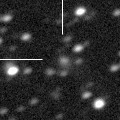
|
Now it is 17.2 mag (Apr. 30, P. Camilleri, H. Williams). In the Southern Hemisphere, it is observable at 17 mag in good condition in spring. It stays extremely low in the Northern Hemisphere.
Date(TT) R.A. (2000) Decl. Delta r Elong. m1 Best Time(A, h)
June 3 12 38.16 -34 33.4 5.268 5.915 125 17.3 19:50 (180, 90)
June 10 12 38.56 -33 19.2 5.345 5.915 119 17.4 19:23 (180, 88)
|

|
It stays 15 mag from 2018 to 2019, and it will be observable for a long time in the Southern Hemisphere. In the Northern Hemisphere, it is observable only until June.
Date(TT) R.A. (2000) Decl. Delta r Elong. m1 Best Time(A, h)
June 3 11 57.90 -26 39.6 5.869 6.375 115 17.6 19:10 (180, 82)
June 10 11 56.88 -26 32.9 5.922 6.333 109 17.6 18:41 (180, 82)
|
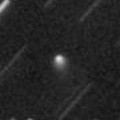
|
It has been 17 mag from 2016 to 2017. It stays bright even after the perihelion passage. It is bright as 17.0 mag still now (May 20, Kunihiro Shima). It is observable in excellent condition in the Northern Hemisphere. It locates somewhat low in the Southern Hemisphere.
Date(TT) R.A. (2000) Decl. Delta r Elong. m1 Best Time(A, h)
June 3 15 13.65 30 56.2 7.304 7.896 122 17.6 22:25 (180, 24)
June 10 15 10.37 31 9.7 7.393 7.927 118 17.7 21:54 (180, 24)
|
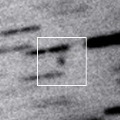
|
It stays observable at 18 mag from spring to summer. It is observable in excellent condition in the Southern Hemisphere. In the Northern Hemisphere, it stays low for a while.
Date(TT) R.A. (2000) Decl. Delta r Elong. m1 Best Time(A, h)
June 3 22 30.94 -33 54.1 5.013 5.361 104 17.8 5:30 (251, 87)
June 10 22 31.99 -33 53.2 4.939 5.381 110 17.8 5:19 (180, 89)
|
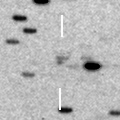
|
Now it is 18.4 mag (May 5, Mt. Lemmon Survey). It will be brightening slowly until autumn when it becomes 16.5-17 mag. It will be getting lower gradually in the Northern Hemisphere.
Date(TT) R.A. (2000) Decl. Delta r Elong. m1 Best Time(A, h)
June 3 14 20.01 -10 30.5 1.707 2.595 143 17.9 21:31 (180, 66)
June 10 14 16.16 -10 32.1 1.730 2.561 136 17.8 21:00 (180, 66)
|
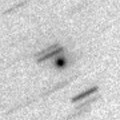
|
Although it was predicted to be fainter than 21 mag, an outburst occured and it brightened up to 15.9 mag (Apr. 21, iTelescope Observatory, Siding Spring). Now it is 17.7 mag (May 15, Kunihiro Shima). It stays observable in good condition for a while.
Date(TT) R.A. (2000) Decl. Delta r Elong. m1 Best Time(A, h)
June 3 13 11.77 -17 37.3 2.682 3.426 130 17.9 20:24 (180, 73)
June 10 13 11.18 -17 13.7 2.800 3.465 123 18.0 19:56 (180, 72)
|
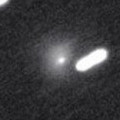
|
Very far object. Outburst occured on Feb. 20, 2015, and it brightened up to 15 mag. Now it is 18.0 mag (Apr. 29, T. Ikemura, H. Sato). It is observable in excellent condition in the Southern Hemisphere. It locates low in the Northern Hemisphere.
Date(TT) R.A. (2000) Decl. Delta r Elong. m1 Best Time(A, h)
June 3 14 23.32 -24 17.9 8.562 9.435 147 17.9 21:35 (180, 79)
June 10 14 22.07 -24 1.0 8.631 9.442 141 17.9 21:06 (180, 79)
|
|
![]()
 217P/LINEAR
217P/LINEAR 29P/Schwassmann-Wachmann 1
29P/Schwassmann-Wachmann 1 C/2017 E1 ( Borisov )
C/2017 E1 ( Borisov ) C/2016 R2 ( PanSTARRS )
C/2016 R2 ( PanSTARRS ) C/2015 VL62 ( Lemmon-Yeung-PanSTARRS )
C/2015 VL62 ( Lemmon-Yeung-PanSTARRS ) 65P/Gunn
65P/Gunn C/2015 O1 ( PanSTARRS )
C/2015 O1 ( PanSTARRS ) C/2016 N4 ( MASTER )
C/2016 N4 ( MASTER ) 73P/Schwassmann-Wachmann 3
73P/Schwassmann-Wachmann 3 C/2016 M1 ( PanSTARRS )
C/2016 M1 ( PanSTARRS ) C/2011 KP36 ( Spacewatch )
C/2011 KP36 ( Spacewatch ) C/2017 D2 ( Barros )
C/2017 D2 ( Barros ) 2P/Encke
2P/Encke C/2016 N6 ( PanSTARRS )
C/2016 N6 ( PanSTARRS ) C/2014 B1 ( Schwartz )
C/2014 B1 ( Schwartz ) P/2000 S1 ( Skiff )
P/2000 S1 ( Skiff ) 81P/Wild 2
81P/Wild 2 C/2017 K4 ( ATLAS )
C/2017 K4 ( ATLAS ) 47P/Ashbrook-Jackson
47P/Ashbrook-Jackson C/2014 OE4 ( PanSTARRS )
C/2014 OE4 ( PanSTARRS ) 315P/2013 V6 ( LONEOS )
315P/2013 V6 ( LONEOS ) 213P/Van Ness
213P/Van Ness C/2016 B1 ( NEOWISE )
C/2016 B1 ( NEOWISE ) C/2014 W2 ( PanSTARRS )
C/2014 W2 ( PanSTARRS ) C/2017 K6 ( Jacques )
C/2017 K6 ( Jacques ) C/2017 D3 ( ATLAS )
C/2017 D3 ( ATLAS ) C/2013 X1 ( PanSTARRS )
C/2013 X1 ( PanSTARRS ) C/2014 R3 ( PanSTARRS )
C/2014 R3 ( PanSTARRS ) C/2017 E3 ( PanSTARRS )
C/2017 E3 ( PanSTARRS ) C/2017 B3 ( LINEAR )
C/2017 B3 ( LINEAR ) C/2015 LC2 ( PanSTARRS )
C/2015 LC2 ( PanSTARRS ) C/2015 H2 ( PanSTARRS )
C/2015 H2 ( PanSTARRS ) 130P/McNaught-Hughes
130P/McNaught-Hughes 157P/Tritton
157P/Tritton C/2013 C2 ( Tenagra )
C/2013 C2 ( Tenagra )![]()



































